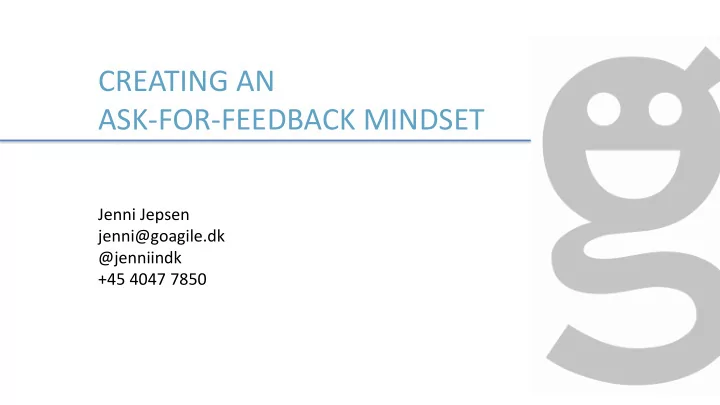

CREATING AN ASK-FOR-FEEDBACK MINDSET Jenni Jepsen jenni@goagile.dk @jenniindk +45 4047 7850
Giving people the answer often results in a disconnect, because their brain is
BEL BELIEF IEFS WE WE HOL OLD TO B O BE TR TRUE UE
We need others to tell us where we should improve
We need others to teach us the skills we are missing
Excellent performance is one size fits all
MISCONCEPTIONS ABOUT FEEDBACK 1. We think people hate feedback. 2. It’s best to focus on errors. 3. Feedback must be ”giver - driven.”
” What do I need to do ” to reach my future goal?
ASK for FEEDBACK
I WANT TO BET BETTER AT… Individually, decide on one thing you want to become even better at doing. Zoom will randomly assign you a partner in a breakout room. In your group, one of you will begin by asking questions to help the other find a clear path to the goal. These questions will focus on the present, past and the future, and are on the next slide. After asking and answering the questions and the time is up, you will switch roles (working with the same partner in your breakout room).
QUESTIONS YOUR PARTNER WILL ASK… THE PRESENT: What are three things (about the improvement item) that are working for you right now? THE PAST: When you had a problem (about the improvement item) in the past, what did you do that worked? THE FUTURE: What do you already know you need to do? What do you already know works in this situation?
The research from the NeuroLeadership jenni@goagile.dk Institute found that our perceptions about giving feedback are wrong. @jenniindk
TIPS TO CREATE AN ASK-FOR-FEEDBACK CULTURE Create an environment where people ASK for feedback: model the behavior you want in the organization (show them what this looks like), put mechanisms in place to nudge people into asking for feedback, and insist on retrospectives and experiment evaluations. Get into the habit of feedback by asking for it more frequently (to reduce feelings of uncertainty around giving and getting feedback). Do it at least 2-3 times per week. Keep feedback focused on tasks: the good things to build on, and where to refocus. When you’re giving the feedback, frame feedback with SCARF in mind (SCARF = Status, Certainty, Autonomy, Relatedness, Fairness) so that you minimize the receiver’s feeling of threat. If someone does not ask for feedback, ask: “Are you open to having a conversation about how to get even better at _________?” Or “What kind of feedback is valuable for you?” Both questions put the receiver in the driver’s seat.
Recommend
More recommend